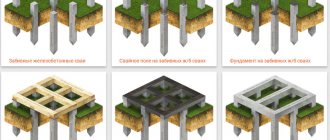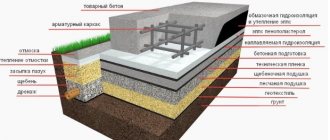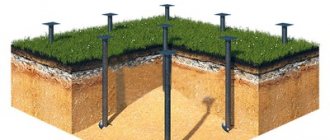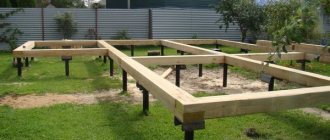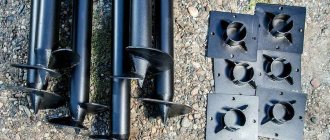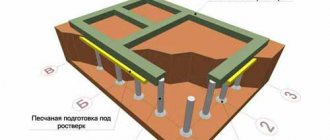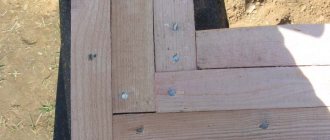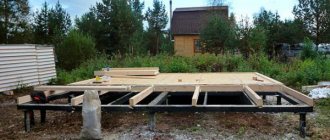When building a house, great importance is given to the construction of the foundation. We have said more than once that the foundation is the foundation of the future home. That's why it needs to be taken seriously. The soil and soil quality of the area where the house will be built is of key importance when choosing the type of foundation. Today we will look at the pros and cons of a pile foundation. The entire construction technology depends on the type of soil on the site, so before starting to build a house, we recommend that you definitely do geotechnical surveys. This will allow you to accurately determine the type of foundation for building your home.
In many regions of Russia, swampy, flooded or weak-bearing soils predominate. This makes the construction process problematic. This is especially true for the construction of private houses. But nevertheless, it is necessary to build somehow, and the use of a traditional strip or even slab foundation on such soils is simply unacceptable. In such cases, a pile foundation comes to the rescue. It is based on the installation of supporting structures. Such structures ensure good contact of the future house with dense layers of soil. And most importantly, they allow you to build very large and massive structures without fear for their stability. But is such a foundation good and safe? Are there any disadvantages of a pile foundation and what are they? Let's sort it out in order.
An example of a pile foundation for a house
Next, we will examine in detail the lighter version of the pile foundation. This includes screw piles. We'll tell you how to install screw piles so that they don't fail. And also what are the advantages of screw piles for the foundation of a house.
Foundation on screw piles
What are screw piles? What are their features and convenience? And how to make a foundation with their help? Screw piles are such a support structure. It is a system of pipes that are immersed in the ground to a certain depth. Spiral blades are welded at the bottom of these pipes (as in the photo). This design allows you to screw piles into the ground. And the blades play the role of cutting, with approximately the same effect as on screws. The sharp tip of the pile makes it easier for it to penetrate the ground. And the thread, in addition to being used for screwing, is also a support unit on which the pile actually rests.
How is the support supported and how reliable is it, you ask? We answer: such a pile is supported by the friction force that occurs between the soil and the side surfaces of the pile (pipe). This design is reinforced by the same blades that we have already talked about. They bear part of the load, which makes such a support very reliable, with proper installation, of course. By the way, the installation of such piles itself has a lot of subtleties that must be observed. Failure to comply with them may result in the pile being flimsy and unreliable. So, in order to evenly distribute the load on each pile, the installation is carried out according to a pre-calculated scheme. A so-called pile field is formed. It ensures an even load on each support.
Grillage
When the piles are already immersed, their upper parts are cut off in such a way that a flat plane is obtained. Then they make a grillage or otherwise call it a load-bearing belt. This is the main structure that distributes the load from the walls. And most importantly, thanks to it, the load on the pile system is distributed evenly, without overloading any of the piles, which gives this structure reliability and durability.
The structure and functions of the grillage are very similar to the design of a strip foundation. The difference in this design is that the grillage, instead of being supported on the ground, like a strip foundation, is supported on piles. In order for the structure to become rigid and less susceptible to lateral loads, the hollow tubes of the piles are filled with concrete after installation. This creates additional stability and rigidity of the structure.
Of course, there are both pros and cons of a pile foundation. But the clear advantage of screw piles is that when installing them, it is not necessary to immerse them until they come into contact with dense layers of soil, as with other piles. The peculiarity of their design allows them to reliably hold the building with sufficient penetration into the ground. Screw piles are a hanging type of piles.
Grillage arrangement
Classification of piles for pile foundations
The strength and service life of a pile foundation depends on the material of the piles. If concrete pillars last 80-100 years, then wooden ones - no more than 30. In weak soil conditions, the structure is in water for most of the year. Wood, even impregnated with hydrophobic agents, begins to rot.
Reinforced concrete beams are more reliable: concrete only becomes stronger under the influence of moisture. Reinforced concrete piles are driven, that is, they are driven into the ground using special driving equipment. The disadvantage of driven piles is the impossibility of installing them near other buildings, since when driving them, due to constant pressure on the ground, the foundation of nearby buildings may be damaged.
According to the principle of load transfer, such supports are divided into rack piles and hanging piles. The racks transfer the weight of the building to dense layers of soil, resting against them with their tip. The hanging beam holds the structure by friction of its side surfaces with the ground. In the first case, there is a pronounced combination of two methods: the pile-rack transfers the load through lateral friction and bearing on deep layers.
Solid metal piles are not considered in the construction of private buildings - such a foundation will be expensive, and the installation of such piles is complicated and impractical. But steel pipes are used in various combinations. One of the methods is this: the pipe is lowered into a pit, three-quarters filled with concrete, and a wooden beam is driven in on top to simplify the installation of the piping.
The advantage of this type of piles is the relative cheapness, and the disadvantage is the relative complexity of installation, since all work will have to be done manually.
One of the modern technologies that has become widespread recently is the construction of bored piles. A bored foundation with a monolithic grillage, built on such piles, can be easily installed with your own hands, significantly saving on materials, and at the same time build both a light frame and a heavy brick house on it. All the pros and cons of this technology are described in the article about the bored foundation.
Another technology that has quickly taken root in low-rise construction is the pile-screw foundation. Its basis is screw piles made of metal. The lower part of the rods has a sharp end and blades in the form of a screw. Screwing a pipe into the ground is often done on your own, but as a rule, special equipment is used for this. The immersion of the barrel is accompanied by compaction of the side walls of the well. Next, the pipe cavity is filled with M300 concrete. One pile can withstand pressure up to 30 tons, depending on its diameter and blade area.
The undeniable advantage of this type of foundation is its low cost and ease of installation. The disadvantages include the susceptibility of metal piles to corrosion, which significantly reduces their service life. On average, the service life of metal piles is 40-60 years, which is quite sufficient for small country houses, but may not be sufficient for houses with permanent residence.
Pros and cons of pile foundations and screw piles
Below we will try to highlight the obvious advantages of screw piles. Of course, any choice in favor of one or another method of installing a foundation depends more on the conditions that exist specifically on your site. But we decided to highlight the general advantages that will help you make a choice based on your individual conditions. And so, the advantages of screw piles include:
- Fast installation.
- Screw piles can be installed manually. This fact makes it possible to build such a foundation next to ready-made buildings.
- Price. Screw piles cost much less than other types of foundations.
- Screw piles can be reused. If the need arises, such piles can be removed and reused elsewhere.
- The big advantage is that installation of screw piles does not require excavation work.
- Screw piles allow construction in areas where there are slopes or folds in the terrain.
- Another important advantage is that during installation you do not need to use complex equipment, which makes the installation process easier and cheaper.
The advantages of screw piles
The disadvantages of a pile foundation and screw piles in particular are given below. The disadvantages are associated not with the structure itself, but with the conditions in which it is unacceptable to use this type of foundation. Here's what it includes:
- Corrosion may appear on the piles, as operating conditions contribute to this.
- In regions where there is high seismic activity, the use of screw piles is prohibited.
- Do not immerse in rocky soil.
- If you plan to install screw piles on loose and weak-bearing soils that do not provide acceptable lateral support for the piles, then additional study is required to determine the sufficient immersion depth of the screw piles.
Often, as it happens, many of the shortcomings of screw piles are deliberately hushed up by manufacturers. In this regard, when choosing a pile type of foundation, you need to understand the design features yourself or have a trusted person who understands this. And most importantly, have an idea of the properties of such piles. To choose the most suitable and high-quality option for screw piles.
Screw pile design
Features of designing a pile foundation
When choosing a pile foundation, it is very important to pay attention to its design in order to build a durable and strong foundation on which any structure will stand. To do this, you need to draw up a detailed design of the pile foundation, which will take into account the following points:
- Soil structure.
- Type of pile foundation.
- A construction site plan showing all buildings.
- The structure plan of an above-ground structure, that is, the number of floors, the use of materials and other features.
- Characteristics of structures that are located near the construction site to determine possible shrinkage.
- Drawing of the underground part of the construction site, that is, the depth of the piles, underground communications.
- Calculation of the load on the floor surface in various situations.
All this data must be taken into account when designing a pile foundation, otherwise the erected structure will not last long.
In conclusion, I would like to note that a pile foundation is a multifunctional and durable foundation for any structure, even despite all its advantages and disadvantages. However, in order to obtain high strength and durability, the foundation design must be carried out using all technologies and preferably with the help of experienced specialists.
What are the types of screw piles?
Screw piles come in various types. They are used depending on soil conditions and other parameters that we will consider. So what are the types of screw supports that are used in the world of modern construction? For convenience, we will divide all types of screw piles into categories.
By area of application in construction
For those who know little about the construction craft, it seems that this type of foundation is used very rarely. But that's not true. This type is used much more widely.
Below we list the areas in which pile structures, screw piles in particular, are widely used:
- Capital construction.
- Individual construction for housing.
- Construction of greenhouses.
- Construction of hangars.
- Fences or enclosures, etc.
- Bridges, piers and other hydraulic structures.
- Load-bearing supports of power lines, masts, etc.
Over the past few decades, the popularity of this type of base has increased significantly. This means that the scope of application of screw piles is only growing and this process is not over yet.
Screw piles design
What are the sizes of piles?
In the manufacture of screw piles, steel pipes of different diameters . Depending on the application, different pile sizes are used. The larger the scale of construction, the thicker the piles should be, this is understandable. But the most common are pipes with a diameter of 108 mm. This size optimally combines fairly good penetration into the ground and high load-bearing capacity.
The diameter range of pile pipes ranges from 57-219 mm. Of course, in some cases, pipes with a larger diameter can be used.
Since the topic of this article is devoted specifically to private housing construction, we will make an amendment that pipes over 159 mm are usually not used. Since with such a thickness there are already certain difficulties in driving piles.
The length of the piles is also key and has several options. Standard sizes range from 1650 mm to 9000 mm. The length of the piles is selected depending on the conditions in which the building must be erected. It is important to understand that the more complex the soil area, the longer the length should be chosen when using piles.
How many blades should there be?
Piles come in various designs. Designs come with one blade or with several blades. Single-blade piles are usually used only on relatively stable soils. Piles with several blades are more suitable for complex and low-bearing soils.
It is important to know. In order not to lose traction with the ground when installing piles, you cannot reverse (reverse movement when screwing in). And also the load on the pile should not be exceeded.
Of course, when constructing important buildings, especially if the soil is weak-bearing, then it is necessary to use multi-bladed piles. Since their design provides greater stability and can withstand higher loads. This is a definite plus in favor of choosing multi-bladed screw piles.
Types of piles
For critical buildings on weak-bearing soils, multi-bladed piles are used, which demonstrate greater resistance to possible loads. Also, an additional argument in favor of choosing just such piles can be the fact that with an increase in the number of blades on the pile, it becomes possible to reduce the diameter of the trunk. And this makes it much easier to dive into the ground.
But it is imperative to ensure that the wall thickness provides the required structural rigidity.
Types of screw pile tips
The main function of the tips is to take on the load when the pile is driven. Therefore, this creates high demands on this structural element. Let's take a closer look at what types of tips there are for screw piles and in which cases which tip is best to use.
Types of screw piles
There are the following types of screw pile tips:
- The first type of tips is welded screw pile tips . They are made by narrowing the thickness of the pipe. Wedge-shaped sections of the pipe are cut out, and then the remaining parts are connected in such a way that a cone is obtained. Next, the seams are welded into a single structure. In this way, a pointed end is achieved. But it is worth noting that this type is only suitable for relatively weak soils. Otherwise, possible obstacles and inclusions of hard areas will simply destroy such a tip.
- The second type of tips, which is distinguished by its reliability and durability, is the cast tips of screw piles. They are made by casting from durable steel, and then additionally attached to the pipe. Such tips are massive, have greater thickness and have the ability to destroy inclusions that occur when installed in the ground. These tips are perfect for difficult soils that have a high density.
Screw pile options
What material are screw piles made of?
The material used for making screw piles is, of course, steel, but the grade of steel may vary depending on the level of construction. Of course, the material directly affects the cost of the pile, so the higher the steel grade, the higher the cost. Usually they use steel from the usual St3 to the more durable St20. If it is necessary to build in highly aggressive soils, where the loads are high and there is the possibility of electrostatic corrosion of the material, fairly durable steel grades 30 KhMA and 09G2S can be used. Below is a table of properties for different grades of steel.
Properties table for various steel grades
Type of protective coating for screw piles
The protective layer that covers ready-made piles is of great importance. Zinc is most often used for these purposes. It is applied in layers to the piles. But the material itself must be very resistant to corrosion. This combination provides good protection, and this in turn increases the service life and reliability of the structure.
The polymer materials that are used for the coating are erased while screwing the piles into the ground, which means they do not fulfill their task. Such a coating is necessary only to protect the outer part of the pile. In addition, this coating requires regular updating.
With the advancement of construction technology, many engineers are proposing innovative methods for protecting piles. They offer different methods from mastics to a rubber layer. But such methods have not yet become widespread and popular among builders.
Advantages and disadvantages
Types of pile foundations are divided primarily according to the method of construction into driven, driven and screw. Each model of a structural element is characterized by its own characteristics.
The general advantages of all types of piles include the following:
Applicability for all types of soils and reliefs of any complexity.
Where laying a strip or slab base would be ineffective or impractical, supports are used. Pile foundations can be built on unstable, waterlogged soils, areas at risk of landslides or flooding, wetlands, as well as on slopes and depressions.- Economic expediency. Laying single load-bearing elements connected into a single structure with strapping costs 30–40% less than constructing a slab or strip buried foundation.
- Possibility to select a power element for any conditions. The popularity of pile technology has led to an increase in offers from pile manufacturers. Today you can select supports with a load-bearing capacity from 0.8 to 15 tons or more, and composite elements are used for deep laying.
- Small amount of excavation work. If, in the case of a buried strip or slab base, it is necessary to dig a pit to the design depth, then to install cast-in-place piles it is enough to drill holes in the ground, and the driven and screw pillars are immersed in the soil by force.
Disadvantages of pile technology:
- Complexity of engineering calculations. Pile foundation technology can satisfy almost all hydrogeological and design conditions, but this will require a number of engineering calculations. Before designing, the designer needs to study the regulatory requirements for the construction of foundations in order to take into account possible nuances for each type of support.
- Labor intensity of work on arrangement of basements. It is possible to organize the construction of underground premises in the space between the power elements, but this will lead to a significant increase in the cost of the project, which will practically cover the benefits of using pile technology.
For a private home
Private residential buildings and cottages are relatively light in weight compared to high-rise buildings and industrial facilities. This feature allows you to abandon the laying of an expensive reinforced concrete strip or slab foundation in favor of factory-made or home-made piles.
Advantages of pile technology for private construction:
- the possibility of laying the foundation with your own hands (screw piles, cast-in-place piles);
- if necessary, methods are available to strengthen the foundation (when building extensions, increasing the number of storeys, replacing floors in a house, etc.);
- maintainability.
Why you should not build a private house on a pile foundation:
- significant heat loss due to the elevation of the house above ground level;
- labor-intensive procedure of engineering calculations;
- There is high seismic activity in the area.
Different types of piles
The choice of piles is based on the results of hydrogeological soil surveys, as well as engineering calculations for design loads. Comparative table of pros and cons for various types of power structures:
| Support type | Benefits of technology | Disadvantages of technology |
| Driven reinforced concrete |
|
|
| Driven steel |
| |
| Driven wooden |
|
|
| Bored |
|
|
| Screw metal |
|
|
| Screw reinforced concrete |
|
|
Optimal screw piles for the construction of a private house
Of course, you must understand that without a preliminary analysis of the soil and the state of the area, it is simply not possible to say that some piles are suitable and others are not. You also need to take into account the weight of the future house, and for this you need to calculate it at the beginning (in this article there are calculation formulas for a slab foundation, but the weight of the house does not change depending on the type of foundation). The table will help you.
Weight calculation
If we proceed from the specifics of the construction, which involves the creation of a relatively light house with a small number of floors, then the most appropriate option would be to use single-bladed trunks with a diameter of 57 to 108 mm, depending on the type and condition of the soil .
Let's take the following data as an example. We are planning to build a relatively light house with a small number of floors. Based on these conditions, the most suitable option would be to use single-blade piles with a diameter of 57 mm to 108 mm. Why is there such a big difference, you ask? Everything is very simple, the choice of diameter will depend on the condition and type of soil on which you plan to build the house. Of course, as we said earlier, in order to get more information and not make a mistake with the diameter and type of screw piles, it is necessary to conduct a survey of the site and a detailed study of the soil.
Another important indicator is the load that will put pressure on the pile. For example, let's say that with a diameter of 57 mm, a pile can withstand a load of approximately 800 kg . So it turns out that naming the pros and cons of a pile foundation and screw piles is not so simple. To do this, you need to know at least the construction conditions, the quality of the soil and the size of the building.
Harness
Pile foundation for a house
Application options
Steel pipe columns allow the construction of 4 types of foundations:
- installation of pile supports under each load-bearing element of a frame building;
- installation of a pile strip in the form of a steel or reinforced concrete grillage;
- pile field for pouring a reinforced concrete slab;
- single supports for the construction of an extension or individual building elements.
Considering all the pros and cons of a pile-screw foundation, it can be considered the best option for installing gates, fences and other types of fences.
The intended use of metal piles is determined by the diameter of the pipe and the size of the blades. In product markings, the first number indicates the size of the pipe string, the second – the blade. Depending on these indicators, it is recommended to use:
- 76 mm pipe for light fences and individual posts;
- 89 mm for canopies, verandas, gazebos and strengthening brick columns;
- 108 mm for frame-type buildings and light houses made of timber;
- 133 mm for structures made of logs or foam blocks.
In this case, double-screw piles with a lower cast tip have the best load-bearing capacity. After screwing in the supports, their internal cavity must be filled with concrete mixture without reinforcement.
The pile-screw type foundation is considered the best solution for use on heaving soils, with high groundwater levels and in wetlands.
For what buildings is it needed?
Screw piles can be used for various buildings. World practice has shown the ability of this type of foundation to successfully work with massive, heavy and tall buildings and structures.
However, in Russia the technology for creating this foundation has not yet been developed, so they are usually limited to the construction of auxiliary or outbuildings. For residential buildings, screw piles are used reluctantly and quite rarely.
Pile foundation, screw
Service life of screw piles
If we take ideal conditions, which means that the soil does not have a destructive effect on the pile material, there is no corrosion, and so on, then the support can last about 300 years. And if you add galvanization of the pile, then it will last for 800 years.
Such statements are made by sellers, manufacturers and marketers of screw piles. Although, if you look soberly, they don’t have much basis for such statements. The thing is that not much time has passed since the invention of screw piles. Not even 300 years old yet. This gives the right not to take such statements and tricks seriously. Of course, there are no ideal conditions, whether we like it or not, the pile will be affected, and the banal fatigue of the metal did not disappear.
Ready piles
So it turns out that the realistic service life of a pile foundation on screw piles can be considered approximately 60-75 years . This depends on the conditions in which the pile will operate and the quality of the installation, as well as compliance with recommendations during processing. But one way or another, these are not absolute values, which means deviations in any direction are possible. But here's an interesting fact. The first engineer-inventor of screw piles, who patented them, Alexander Mitchell (April 13, 1780 - June 25, 1868) built structures on screw piles. He first proposed such piles as a support in 1833 in England. And what’s interesting is that some of the buildings are still standing and in use today. And almost 200 years have passed...
Alexander Mitchell aged 86 (April 13, 1780 – June 25, 1868)
DIY bored pile foundation
The step-by-step instructions presented below provide for the independent construction of a bored pile foundation with a grillage on top. This is the most popular option among private owners, as it is easy to implement. For the work you only need asbestos cement pipes, concrete mortar and steel or fiberglass reinforcement.
The device is completed in five stages:
- Excavation.
- Installation of asbestos-cement pipes and laying fittings in them.
- Pouring concrete.
- Grillage arrangement.
- Closing the base.
For the manufacture of bored piles, asbestos-cement pipes with a diameter of 300–400 mm are required. They will serve as a guarantee that the foundation will have good load-bearing capacity both vertically and horizontally. And unlike the steel version, asbestos cement will not rust in the ground.
The easiest way to make holes for supports is to use a hand drill with a gasoline or electric motor. The depth of these holes should ultimately be 30–40 cm below the freezing point of the soil.
Pile pillars are located around the perimeter of the building and under the load-bearing walls inside in increments of up to two meters. After drilling the wells, a sand cushion 10–15 cm thick is poured at their bottom. Then, another 25–30 cm of concrete is poured on top as a support for the piles. And asbestos-cement pipes are installed into this uncured solution. At the same time, they must protrude at least 30 cm above the ground.
To ensure that the pipes remain strictly in an upright position, they are sprinkled with sand, which is compacted during this process. Next, the support pillars are reinforced. For this, 3-4 rods made of steel or fiberglass with a cross-section of 10–12 mm are used.
Reinforcing rods must be placed in the center of the pipe at an equal distance from each other. To simplify installation, they can be tied together on the ground with wire crossbars. In height, these vertical rods should be higher than the upper edge of the pipe, protruding from the latter by 15–20 cm. After reinforcement, all that remains is to fill this permanent formwork with concrete, making sure that no voids form inside the solution.
After just 3-4 days, a grillage made of reinforced concrete (with laying of formwork, reinforcement and pouring of concrete mixture), steel channel or timber can be mounted on the resulting supports. As a result, there should be a gap of 25–30 cm between it and the ground. It is impossible to lay the grillage directly on the ground; when it heaves, it can simply be squeezed up and demolished along with the building.
At the end of the arrangement, it is best to cover the sides with sheathing after the walls have been erected. Corrugated sheeting for the roof or facade or decorative bricks are perfect here. Just first you need to lay out all communications. Fortunately, water supply and sewerage in a house on stilts are carried out between the supports without additional tricks or drilling of concrete.
Can a pile foundation be considered capital?
Screw piles that are screwed into the ground can really withstand enormous loads. And be the foundation for heavy and massive structures. This gives grounds to rightfully consider foundations on screw piles not just full-fledged capital ones, but also very reliable.
In this matter, a certain psychological imbalance arises, since outwardly they do not look like a reliable support corresponding to the term “capital”.
Often people are scared by the appearance of such a design. From the outside, the piles look very flimsy and it’s hard to believe that such a support can support a large house. Because of this appearance, people simply have an imbalance. How can “this” be called “capital”? But engineers say the opposite; an indicative factor is that it is allowed to build residential buildings on pile foundations. This allows us to say with confidence that screw piles are a reliable and permanent type of foundation .
House on screw stilts
Combining piles with a grillage
It is advisable to combine free-standing piles with a grillage into a single structure. This will help it resist the forces of frost heaving of the soil.
A pile foundation, reviews of each type of which can be read on specialized forums, can be left without a grillage. In this case, you need to have complete confidence that the piles are deep enough and will not sag over time.
A pile foundation, the disadvantages of which can be considered insignificant, requires preliminary calculations and preparatory work.
How to make the right choice?
Having learned most of the pros and cons of a pile foundation, a logical question arises. How to choose screw piles, what you need to pay attention to when choosing so that they last a long time. When choosing screw piles, you need to concentrate on two components of this process.
- Determine the standard size and type of screw piles that are suitable specifically for your conditions, your soil and your house design.
- Directly select products that suit you, taking into account their quality and price.
When working with a construction company, these two stages are reduced to a minimum of your attention. The first stage is most often decided at the design stage of the future home. But the second stage is a question for the employees of the company that is building your house.
It also happens that you build a house yourself. Read about the pros and cons of such construction in the previous article. In this case, you need to choose screw piles personally. Here is a list of what you need to pay attention to when choosing screw piles.
- The pipe must have a wall thickness of at least 4 mm.
- The pile blade must have a thickness of at least 5 mm.
- Monitor the quality of welding and weld seams, they should be of the highest quality.
- A layer of galvanization is required; this will provide additional protection and increase service life.
- The tip matters too. We talked about their types. It is advisable to choose a higher quality one.
These few points will help you choose the best product. Do not choose piles based only on price, otherwise you will have to lose a lot more effort, time and money when demolishing an already finished house. Focus only on quality. If you are in doubt and feel that a certain type of product does not fully meet your requirements, it is better to refuse such a purchase. Otherwise more problems will arise.
Pros and cons of a pile foundation. Screw piles
Advantages
The reliability and durability of the planned structure depends on the correct choice of foundation. To evaluate the advantage of screw piles, it is necessary to analyze a number of factors:
- Price . Unlike the use of conventional columnar supports and shallow tape, the installation of screw piles will cost the developer 20-30% less. And if we are talking about the need to lay a reinforced concrete strip or monolithic slab to a considerable depth, then the savings will be much greater.
- Difficulty of construction . Labor costs for installing a pile-screw foundation directly depend on the type of structure of the future building, as well as the need to bury the supports below the frost line. In areas with particularly unstable soil, it is advisable to additionally install a drainage system. If you plan to build a small-sized building with low weight, then 3 people are enough to install screw piles. But for large-scale construction you will have to hire special equipment. hydraulic excavators, drilling rigs and other machines.
- Installation speed . To install the presented type of foundation, no excavation work is required. In addition, after screwing in the piles, you can immediately proceed to the next stage of construction. As a rule, installation of such a foundation does not take longer than 2 days.
- Seasonality . The installation of piles can be done at any time of the year, which is a definite advantage, because working with concrete mixtures in winter is accompanied by additional costs for anti-frost additives.
- Relief of the site . The use of screw piles is especially advisable if the site is characterized by large differences in height (up to 8 m). Reinforced concrete foundations also cope with this task, but it will cost the developer several times more.
- Soil subsidence . Screw piles are best suited for building foundations in conditions with moisture-saturated soil masses subject to heaving forces.
- Maintainability . If for any reason one of the supports bursts during operation, it can be quickly replaced with a new one without compromising the integrity of the structure.
- Thermal and waterproofing . The design feature of this type of foundation involves an air gap between the ground surface and the zero floor of the house. Thanks to this, the humidity and temperature of the earth do not in any way affect the structure itself.
- Prospects for the developer . In the future, if the owner of the house wants to increase the area of the building, it is possible to screw in additional supports to strengthen the structure.
- Life time . High-quality metal supports, the body of which is complicated by blades of various configurations, can last up to 80 – 100 years.
Screw piles, product prices
Like any other parameters, the cost is calculated based on the conditions of future construction. Therefore, each individual house project will have its own cost. We will take a very small project to simply show a diagram of how to calculate the cost. So that you can independently calculate the cost of a pile foundation for your project. So, our example will be as follows: we will calculate the cost of a screw-type foundation for a house 6 by 6 m. Based on the fact that the optimal layout of a pile field should consist of at least 9 piles. This is what we have.
Depending on the company and conditions, the customer will need to pay for the installation of each pile. The cost of installation will be approximately from 650 rubles to 1150 rubles per piece. And add here the price of the screw piles themselves. The price of screw piles depends on the diameter and length of the trunk. For example, BC-57, this means that a diameter of 57 mm and a length of 3 meters will cost 1100 rubles with installation or 1200 without such a service. If the product is selected BC-108, then the price, also for a 3-meter trunk, will range from 1150 rubles with installation of products and 1350 rubles without such a service.
Choosing a company for installing screw piles
Why is there a difference in price depending on the presence or absence of the installation option, you ask. It’s very simple; this move is designed to encourage the buyer to order installation of screw piles from the same company. Of course, such a choice is not always the best solution, this is due to the quality of the installation. It is necessary to study the history of installations of this company, read the reviews and only then make a final decision in favor of this option. Or, on the contrary, turn to another company that specializes in installation, and not in the sale of screw piles.
As a result, for our example, the cost of this type of foundation will be only about 20 thousand rubles. But please note that we only calculated the cost of the products themselves and their installation. You also need to add additional shipping costs and other overhead costs. keep this in mind.
Of course, depending on the company, prices may vary, but ours shows the average price. Therefore, be sure to find out the cost of all options and ask for a detailed report of what and how much it costs.
Cost calculation
Pile foundation construction technology
Compliance with the technology for installing a pile foundation will allow you to build a solid foundation. Manufacturing the structure involves the following steps:
- Drilling holes. Their number is determined by the total weight of the structure, as well as the operational load. The diameter of the hole depends on the technical parameters of the drill, but it rarely exceeds 30 cm. The depth of the hole is no more than 6 m. The drill is positioned so that minimal effort is used during operation.
- Concreting and reinforcement of elements. To protect products from moisture, roofing material is placed in the wells along the entire diameter. After this, piles will be placed in the holes. Concrete is used to secure them. Groundwater is pumped out. It is also important to organize the frame from reinforcement. Concrete must be supplied in layers and compacted.
- Grillage arrangement. Its height is at least 30 cm, width is at least 40 cm.
Finally, all seams are filled with cement mortar.
Brief and general installation diagram
Here we will very briefly, point by point, provide you with the procedure for installing screw piles. If you have never done installation before, be sure to study this material in more detail. The matter is not complicated, but there are many nuances that simply must be observed. Procedure:
- Mark the pile field.
- Screwing in piles.
- Filling pipe cavities with concrete.
- Trimming the tops to achieve a level surface.
- Install headers.
- Installation of grillage.
In modern construction, specialized machines are used to screw in piles. This machine provides better and faster installation of screw piles. And most importantly, it will ensure verticality, and there will be no rocking of the pile during screwing. And this, in turn, will give the most intimate contact with the ground. It is also advisable to treat welding areas and any damage found that appeared during the process with an anti-corrosion compound.
So we have finished studying the possible pros and cons of a pile foundation and screw piles in particular. Before you take action, be sure to read the reviews below . Since opinions about screw piles differ, and people say different things. Everything is very individual, so always choose based on your conditions for building a house.
Scheme for using screw piles
Driving screw piles
About piles for foundation
At the bottom of the piles there are blades; they have the shape of a screw.
With the help of the structure, the piles are screwed into the ground like self-tapping screws, but in this case the soil is not destroyed, but compacted and becomes stronger.
Types by shape
There are three types of piles for foundations, more about them below.
Screw piles
They have helical blades; this type of piles is used where the bearing capacity of the soil is poor. A large number of screw piles have a cutting element, which cuts the soil when the pile is screwed into the ground. This type of pile is also suitable for soil that freezes all the time.
Piles with different pipe diameters
The diameter of the pile pipe will determine its weight and ability to withstand enormous loads. After all, when choosing these piles, you need to focus on the entire mass of the building and in relation to this indicator you need to choose the diameter of the pile. For piles whose diameter is more than 10 cm, special equipment will be required.
Blades having different diameters on the same pile
If the soil is very wet, then the diameter of the pile blades is larger.
Piles also have differences in shapes and types. These data vary by manufacturer and materials.
Types by tip
So screw piles are divided according to the type of tip, and they are:
- welded;
- cast.
Welded
The option is considered cheap and economically feasible, because it consists of a pipe with a blade welded to it. Such piles are not of very good quality and for this reason, welded piles are not used in the construction of mass structures.
Such piles are used for the construction of garages or outbuildings. If the blade on the pile is not welded well, then during operation it may move away from the vertical axis and therefore the foundation loses its stability.
Cast
Piles with a cast tip have good strength. They are used for the construction of residential buildings. To make a cast tip, the casting method is used. The blades of the piles are approximately 12 millimeters thick and approximately 30 centimeters in diameter.
To produce a pile shaft, take a steel pipe with a tip. Cast piles have good load-bearing capacity; they can withstand loads of more than five tons or more. Of course, the cost of a cast tip is slightly higher than that of a welded one.
Types by coverage
Piles also differ in the type of coating. Steel is sometimes treated with an anti-corrosion agent, and sometimes with a polymer coating.
A foundation made of screw piles, if the load on it is accurately calculated, can last more than a hundred years.
When purchasing piles on the market, you must familiarize yourself with the certificate of compliance with factory standards and all standards. Because there are a huge number of fakes that look no different from real piles.
There is another option for piles, for the production of which thick-walled pipes are used. In terms of reliability, such piles are on the same level as cast piles. Piles provide a strong foundation for large structures.
Pros and cons of screw piles
Pros of screw piles and their advantages:
- Speed of foundation construction;
- There is no need to wait for the foundation to be built;
- Screw piles are easy to install. Piles can be installed with your own hands, but if the size of the piles is large, then you need to hire special equipment;
- Affordable price;
- Can be used on various soils;
- Does not require preliminary leveling of the site;
- Good load resistance;
- Long service life;
- Does not require excavation work.
Disadvantages of screw piles and their disadvantages:
- If you choose low-quality piles, they quickly fail and lead to uneven subsidence of the structure;
- If the soil contains a large number of stones, then installing piles will be difficult;
- The need to comply with installation and technology rules.
Pros and cons of a pile foundation - reviews
Nikolay 5/5
It's been standing for 7 years now. The house on screw stilts showed excellent results. There are no comments or complaints, everything is reliable and durable. There have been no problems during these seven years. Many people complain that they made a mistake with the choice of piles, saying they rust and other diseases. In my case, I somehow didn’t notice anything like that. Of course, you need to tint it occasionally, but like any iron you need to paint it, otherwise what kind of owner are you?!
Alexander 3.5/5
I think that messing with screw piles is simply dangerous. Yes, I don’t want to say anything bad about the design. But the ease of installation would seem to be a plus, but nope. This business attracts a lot of crooks. They installed piles in the sand for us. They dug holes for no reason, although it is forbidden to do so. Then they screwed one in just 1.5 m and they said that there was no further movement. The reason given was that the pile failed. Of course, I realized that things were not going well and refused their services, found another company and entered into an agreement with it. And what do you think??? For some reason, all their piles went in like clockwork and to the required depth. Therefore, I want to warn everyone that they need to watch the installation carefully. Otherwise, God forbid, the house will collapse in half a year.
Angelina 2/5
We got acquainted with piles while building a bathhouse; my husband built it on screw piles. And now he’s offering to build a house on them, but I somehow doubt and am afraid. And their service life, as they say, is 50 years. How is it usually only 40? They rust constantly and need to be painted. But the bathhouse has been working great for 4 years now and no problems. But a bathhouse is one thing, and a house is completely different. I persuade my husband not to install it; I still want reliability for the house.
Pros and cons of a pile foundation - reviews
Andrey 3.5/5
When purchasing piles, I recommend everyone to look at the protective coating layer. In most companies, they coat everything with paint, but it falls off during installation. If you suddenly have even the slightest doubt, look for other piles; there are a lot of them now. The thickness of the metal also matters a lot. It happens that when screwing them in like an accordion, they simply twist. I almost got caught while taking piles. The sellers said that everything was safe and normal. But the pipes look flimsy and are also painted with some kind of red paint. It was good to hire a man who understands it, he criticized these piles so much that he immediately abandoned them.
Victor 3/5
I built a house 8.5 by 9 m. The sway is not bad, it is especially noticeable on the second floor. 26 piles, 108 mm ones were screwed in. But problems arose with the depth; they did not enter uniformly due to the complexity of the soil. One is 1.5 m, the other is 2.5 m. It seems like they did everything wisely, they turned the machine, the harness was done properly. The reason for the swinging has not been figured out, but I personally blame the piles.
Vladislav 3.5/5
There was little time and not much money, so I decided to build a 6 by 6 country house on screw piles. I was amazed how quickly all the work was done. Literally 3 days for everything about everything. And they tied it up quickly with a grillage. And the price pleasantly surprised me; I gave it half as much as any strip foundation would cost, as they calculated for me. And you can’t make a strip foundation in 3 days. The only drawback is that you have to apply anti-corrosion agent occasionally.
Preliminary calculations for the construction of a pile-screw foundation
Before purchasing all-metal hollow pipes, you need to decide on their number and diameter. Each pile can withstand loads of up to 6 tons. Their number is determined based on the material of the future building. For a wooden house, it is enough to install piles every 2.0-2.5 m. When using heavier materials, they will need to be deepened at a distance of 1.5-2.0 m.
The length of piles for low-rise construction usually does not exceed 3.5 m. In some regions this figure may be higher. The diameter of the products is usually 57-133 mm. After calculating the required number of piles and their length, you can purchase all materials.
Pros and cons of a pile foundation - reviews
Kirill 2/5
On the site I placed the gazebo on screw piles. But the neighbor had seen enough and built a one-and-a-half-story house on them. Of course he doesn’t complain, but I see how he crawls and works on his foundation twice a year. And it’s scary to look at, everything looks so flimsy. I think that there is no point in putting more gazebos and fences on such a foundation.
Mikhail 5/5
He built a wooden house from logs. But there wasn’t much money, I read a lot and decided to choose a foundation on screw piles. The house was small, 6 by 6. I installed 9 piles. The soil on the site is mostly loam, so we were lucky to drive it all the way to 3 meters. The check showed that the piles fit perfectly and do not wobble. Although many advised against installing piles, arguing that they were wobbly and not reliable at all. The house has been standing for two years now and I haven’t noticed any problems at all.
Peter 1.5/5
They built a frame house 6 by 9 meters. I chose the type of foundation - screw piles. The work took 3 months. At first we were very happy that we managed to build the house so quickly. But now, when I walk around the house or the washing machine is running, I can feel the vibration of the floor and walls. They say that the distances between the lags were large, but it seems to me that the piles failed.
